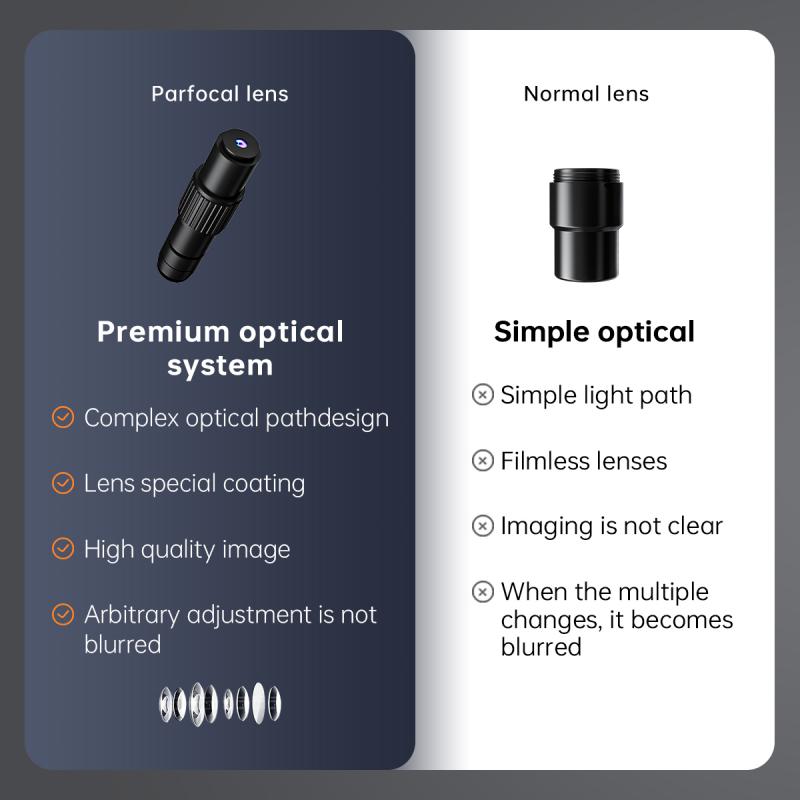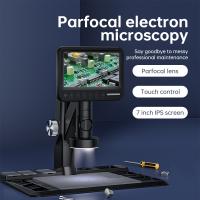What Can A Microscope See ?
A microscope can see objects that are too small to be seen with the naked eye. It can magnify the size of the object and reveal details that are not visible to the human eye. Microscopes are commonly used in scientific research, medical diagnosis, and education to study cells, microorganisms, and other small structures. They can also be used to examine the structure of materials, such as metals and crystals, at a microscopic level. The type of microscope used depends on the object being studied and the level of detail required. Light microscopes use visible light to magnify the object, while electron microscopes use beams of electrons to create a highly detailed image.
1、 Microorganisms and cells
What can a microscope see? A microscope can see microorganisms and cells. Microorganisms are tiny living organisms that are too small to be seen with the naked eye. They include bacteria, viruses, fungi, and protozoa. A microscope can magnify these microorganisms, allowing scientists to study their structure, behavior, and function. For example, a microscope can reveal the shape and size of a bacterium, the structure of a virus, or the movement of a protozoan.
Similarly, a microscope can also see cells, which are the basic building blocks of life. Cells are the smallest unit of life that can carry out all the functions of an organism. A microscope can magnify cells, allowing scientists to study their structure, function, and behavior. For example, a microscope can reveal the structure of a plant cell, the movement of a white blood cell, or the division of a cancer cell.
The latest point of view is that microscopes have advanced significantly in recent years, allowing scientists to see even smaller structures and details. For example, electron microscopes can magnify objects up to 10 million times, revealing the structure of molecules and atoms. Additionally, new techniques such as super-resolution microscopy can reveal details at the nanoscale level, allowing scientists to study the structure and function of cells and microorganisms in unprecedented detail. Overall, microscopes are powerful tools that have revolutionized our understanding of the microscopic world.

2、 Tissues and organs
A microscope can see tissues and organs at a cellular level. It allows us to observe the intricate structures and functions of cells that make up tissues and organs. With the advancement of technology, microscopes have become more powerful and sophisticated, allowing us to see even smaller structures such as organelles within cells.
Microscopes have been instrumental in the field of medicine, allowing doctors and researchers to diagnose and study diseases at a cellular level. For example, a microscope can be used to examine a tissue sample from a patient with cancer to determine the type and stage of the disease. This information can then be used to develop a treatment plan.
In recent years, new techniques such as confocal microscopy and super-resolution microscopy have been developed, allowing us to see even smaller structures and processes within cells. These techniques have revolutionized our understanding of cellular biology and have led to new discoveries in fields such as neuroscience and immunology.
Overall, a microscope is a powerful tool that allows us to see the intricate structures and functions of cells, tissues, and organs. With continued advancements in technology, we can expect to gain even more insight into the complex world of cellular biology.

3、 Molecular structures and interactions
A microscope is a powerful tool that can reveal the hidden world of the very small. It can see things that are too small to be seen with the naked eye, such as cells, bacteria, and viruses. However, the capabilities of a microscope go beyond just seeing these basic structures. A microscope can also reveal the molecular structures and interactions that make up these structures.
Molecular structures and interactions refer to the way that atoms and molecules come together to form larger structures. These structures can be seen using a variety of microscopy techniques, such as electron microscopy and atomic force microscopy. These techniques allow scientists to see the individual atoms and molecules that make up a structure, and to understand how they interact with each other.
The latest point of view on what a microscope can see is that it can reveal the dynamic nature of molecular structures and interactions. Scientists are now able to use advanced microscopy techniques to watch molecules in action, as they move and interact with each other in real-time. This has led to new insights into how biological processes work, and has opened up new avenues for drug discovery and development.
In conclusion, a microscope can see much more than just basic structures. It can reveal the molecular structures and interactions that make up these structures, and can provide a dynamic view of how these structures work. With the latest advances in microscopy, scientists are able to see the hidden world of the very small in unprecedented detail, and this is leading to new discoveries and breakthroughs in many fields of science.

4、 Nanoparticles and materials
A microscope is a powerful tool that can see objects that are too small to be seen with the naked eye. It can magnify objects up to thousands of times their original size, allowing us to see the intricate details of the object's structure. One of the things that a microscope can see is nanoparticles and materials.
Nanoparticles are tiny particles that are less than 100 nanometers in size. They are used in a wide range of applications, from medicine to electronics. A microscope can be used to observe the size, shape, and distribution of nanoparticles. It can also be used to study the properties of materials at the nanoscale, such as their electronic, optical, and magnetic properties.
The latest point of view on the use of microscopes to study nanoparticles and materials is that it is essential for the development of new technologies. For example, researchers are using microscopes to study the behavior of nanoparticles in biological systems, which could lead to the development of new drug delivery systems. They are also using microscopes to study the properties of materials at the nanoscale, which could lead to the development of new materials with unique properties.
In conclusion, a microscope is a powerful tool that can see nanoparticles and materials. It is essential for the development of new technologies and is used by researchers to study the properties of materials at the nanoscale. With the latest advancements in microscopy technology, we can expect to learn even more about the behavior of nanoparticles and materials in the future.































There are no comments for this blog.